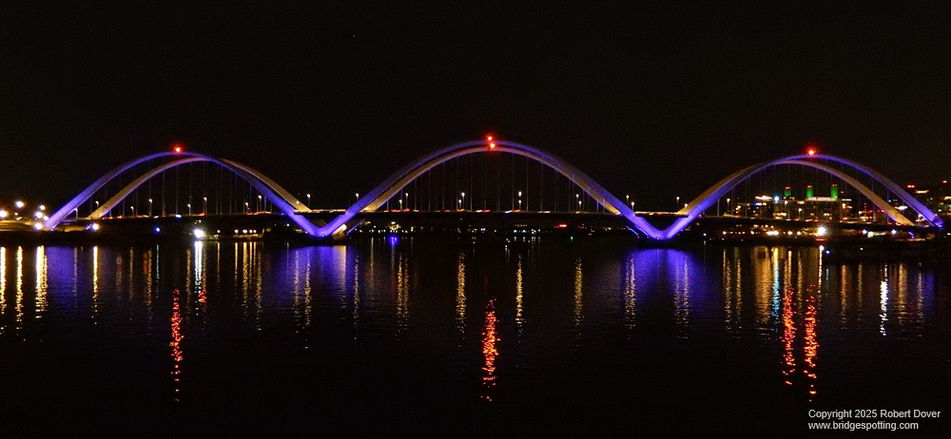Photographs of the Bridges
Frederick Douglass Bridge, Washington, DC
The gleaming white, curved arches of the new Frederick Douglass Bridge rising above the tops of the surrounding buildings in 2020 came as a bit of a shock to Washington, DC residents. For well over 100 years, the District was a city that eschewed modernist architecture in favor of classical and monumental styles, and that also famously banned any tall, prominent structures by law. Even worse, it was a city whose rivers were dominated by unappealing, utilitarian mid-century interstate highway bridges – including the original Frederick Douglass Bridge at this location near the confluence of the Anacostia and the Potomac. Architecture like this was simply not done, and it most definitely was not done in such a prominently visible location. And the final argument against the bridge was its location in Southeast DC, a neighborhood known as Anacostia, which for decades had been the run-down, industrial part of the city.
That was the situation up into the 1990s, when multiple federal and city agencies, agencies from nearby states and counties, non-profit environmental organizations, and other partners began a thirty-year, concerted effort to “clean up” the Anacostia River and its adjacent waterfront neighborhoods, both figuratively and literally. Perhaps the most aspirational part of this plan was to lure a major league baseball team to a city that had already lost two of them, and then spend hundreds of millions of dollars to build a baseball stadium at the end of an unattractive, industrial-looking bridge, for a losing team, in a depressed, formerly industrial part of town that few suburbanites would ever willingly visit. Things did not get better as the real estate market immediately tanked into the Great Recession, the promised residential and commercial developments did not materialize, and the baseball team lost more than 100 games for two years in a row.
Proving that urban renewal is a marathon and not a sprint, the Capitol Riverfront became, by the mid-2010s, one of the most desirable neighborhoods in the city. And, once this success had been established, the old, unattractive Frederick Douglass Bridge became a drag on further development. The new glass-sided, high-rise condos and offices provided spectacular views of the ballpark and the river, but also highlighted the aesthetic limitations of the bridge. In addition to it structural limitations, the aesthetic shortcomings of the bridge itself were partially responsible for holding back development in the hottest real estate market in town.
In 2012, the District began the planning for the replacement of the bridge, a replacement that would fully embrace all of the precepts of twenty-first century bridge design. It is not just aesthetically pleasing, but its three high, white arches serve as a work of public art deserving of its prominent location just down the street from the U.S. Capitol. A pleasing feature of the modernistic design of the arches is the manner in which they are a smooth continuation of the concrete, V-shaped piers. The profile of the bridge does not have any sharp angles to it. Instead, the superstructure is almost serpentine, with each arch descending smoothly to a curve at the base of the pier, and then smoothly rising again to the next arch. The effect is even more pronounced at night, because the arches and piers are lit in bright, pastel colors, but the deck is not. This makes the deck all but invisible, leaving only the series of smooth, bright, pastel-colored arches displayed against the background. At each pier, between the arches, the sidewalk widens out into a viewing platform, providing a view of the new developments along The Yards Park.
The new bridge was opened to traffic in 2021, but its effects on spurring additional redevelopment in the Near Southeast neighborhood has only just begun, as of 2025. The role of the bridge in spurring this re-development is discussed in Chapter 3 of my book, Bridgespotting Part 2: A Guide to Even More Bridges that Connect People, Places, and Times.


















